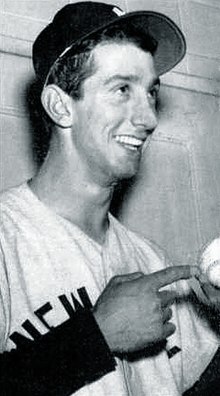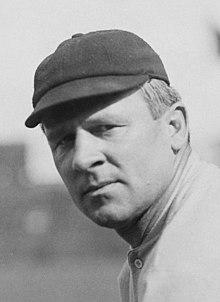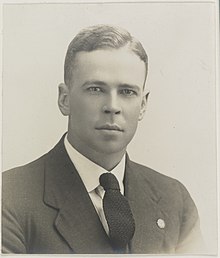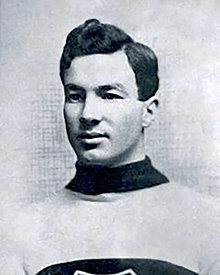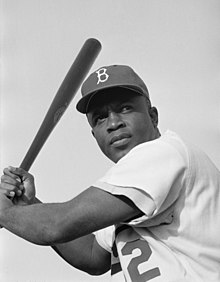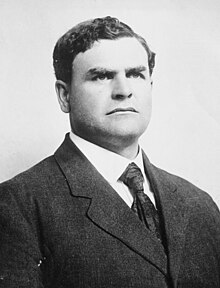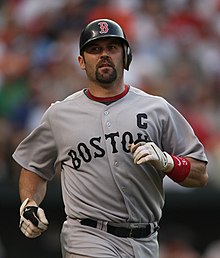Portal:Baseball
Portal maintenance status: (June 2018)
|
| Main page | Content, Categories & Topics | WikiProjects & Things you can do |
The Baseball Portal
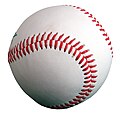
Baseball is a bat-and-ball sport played between two teams of nine players each, taking turns batting and fielding. The game occurs over the course of several plays, with each play generally beginning when a player on the fielding team, called the pitcher, throws a ball that a player on the batting team, called the batter, tries to hit with a bat. The objective of the offensive team (batting team) is to hit the ball into the field of play, away from the other team's players, allowing its players to run the bases, having them advance counter-clockwise around four bases to score what are called "runs". The objective of the defensive team (referred to as the fielding team) is to prevent batters from becoming runners, and to prevent runners' advance around the bases. A run is scored when a runner legally advances around the bases in order and touches home plate (the place where the player started as a batter).
The opposing teams switch back and forth between batting and fielding; the batting team's turn to bat is over once the fielding team records three outs. One turn batting for each team constitutes an inning. A game is usually composed of nine innings, and the team with the greater number of runs at the end of the game wins. Most games end after the ninth inning, but if scores are tied at that point, extra innings are usually played. Baseball has no game clock, though some competitions feature pace-of-play regulations such as the pitch clock to shorten game time.
Baseball evolved from older bat-and-ball games already being played in England by the mid-18th century. This game was brought by immigrants to North America, where the modern version developed. Baseball's American origins, as well as its reputation as a source of escapism during troubled points in American history such as the American Civil War and the Great Depression, have led the sport to receive the moniker of "America's Pastime"; since the late 19th century, it has been unofficially recognized as the national sport of the United States, though in modern times is considered less popular than other sports, such as American football. In addition to North America, baseball spread throughout the rest of the Americas and the Asia–Pacific in the 19th and 20th centuries, and is now considered the most popular sport in parts of Central and South America, the Caribbean, and East Asia, particularly in Japan, South Korea, and Taiwan. (Full article...)
 Featured articles - load new batch
Featured articles - load new batch
-
Image 1Advertisement in Billboard magazine in 1907
How Brown Saw the Baseball Game is an American short silent comedy film produced in 1907 and distributed by the Lubin Manufacturing Company. The film follows a baseball fan named Mr. Brown who overdrinks before a baseball game and becomes so intoxicated that the game appears to him in reverse motion. During production, trick photography was used to achieve this effect. The film was released in November 1907. It received a positive review in a 1908 issue of The Courier-Journal that reported the film was successful and "truly funny". As of 2021[update], it is unclear whether the print of the film has survived. The identities of the film cast and production crew are unknown. Film historians have noted similarities between the plot of How Brown Saw the Baseball Game and How the Office Boy Saw the Ball Game. It is a comedy film directed by Edwin S. Porter, having released a year before How Brown Saw the Baseball Game. (Full article...) -
Image 2
Daniel Lucius "Doc" Adams (November 1, 1814 – January 3, 1899) was an American baseball player and executive who is regarded by historians as an important figure in the sport's early years. For most of his career he was a member of the New York Knickerbockers. He first played for the New York Base Ball Club in 1840 and started his Knickerbockers career five years later, continuing to play for the club into his forties and to take part in inter-squad practice games and matches against opposing teams. Researchers have called Adams the creator of the shortstop position, which he used to field short throws from outfielders. In addition to his playing career, Adams manufactured baseballs and oversaw bat production; he also occasionally acted as an umpire.
From 1847 to 1861, the Knickerbockers selected Adams as their president six times, and as a vice president, treasurer, or director in six other years. As president of the club, Adams was an advocate of rule changes in baseball that resulted in nine-man teams and nine-inning games. When the National Association of Base Ball Players (NABBP) was formed in 1858, he led the rules and regulations committee of the new organization. In his role, Adams ruled that the fields' bases should be 90 feet (27 m) apart, the modern distance, and supported the elimination of the "bound rule", which allowed for balls caught after one bounce to be recorded as outs. He resigned from his positions with the Knickerbockers and NABBP in 1862. Adams' contributions in creating baseball's rules went largely unrecognized for decades after his 1899 death, but in 1980 a letter about him appeared in The New York Times; by 1993, researcher John Thorn had written about Adams' role. Other historians have given him credit for helping to develop the sport, and Thorn has called Adams "first among the Fathers of Baseball". (Full article...) -
Image 3
Alfred Manuel "Billy" Martin Jr. (May 16, 1928 – December 25, 1989) was an American Major League Baseball second baseman and manager who, in addition to leading other teams, was five times the manager of the New York Yankees. First known as a scrappy infielder who made considerable contributions to the championship Yankee teams of the 1950s, he then built a reputation as a manager who would initially make bad teams good, before ultimately being fired amid dysfunction. In each of his stints with the Yankees he managed them to winning records before being fired by team owner George Steinbrenner or resigning under fire, usually amid a well-publicized scandal such as Martin's involvement in an alcohol-fueled fight.
Martin was born in a working-class section of Berkeley, California. His skill as a baseball player gave him a route out of his home town. Signed by the Pacific Coast League Oakland Oaks, Martin learned much from Casey Stengel, the man who would manage him both in Oakland and in New York, and enjoyed a close relationship with Stengel. Martin's spectacular catch of a wind-blown Jackie Robinson popup late in Game Seven of the 1952 World Series saved that series for the Yankees, and he was the hitting star of the 1953 World Series, earning the Most Valuable Player award in the Yankee victory. He missed most of two seasons, 1954 and 1955, after being drafted into the Army, and his abilities never fully returned; the Yankees traded him after a brawl at the Copacabana club in New York during the 1957 season. Martin bitterly resented being traded, and did not speak to Stengel for years, a time during which Martin completed his playing career with various teams. (Full article...) -
Image 4
John Joseph McGraw (April 7, 1873 – February 25, 1934) was an American Major League Baseball (MLB) player and manager who was for almost thirty years manager of the New York Giants. He was also the third baseman of the pennant-winning 1890s Baltimore Orioles teams, noted for their innovative, aggressive play.
McGraw was born into poverty in Truxton, New York. He found an escape from his hometown and a bad family situation through baseball, beginning a quick rise through the minor leagues that led him to the Orioles at the age of 18. Under the tutelage of manager Ned Hanlon, the Orioles of the 1890s won three National League (NL) pennants; McGraw was one of the stalwarts of the team alongside Wee Willie Keeler, Hughie Jennings, and Wilbert Robinson. The Orioles perfected the hit and run play and popularized the Baltimore chop; they also sought to win by intimidating the opposing team and the umpire. (Full article...) -
Image 5
Herschel Greer Stadium was a Minor League Baseball park in Nashville, Tennessee, on the grounds of Fort Negley, an American Civil War fortification, approximately two mi (3.2 km) south of the city's downtown district. The facility closed at the end of the 2014 baseball season and remained deserted for over four years until its demolition in 2019. Following an archaeological survey, the land is expected to be reincorporated into Fort Negley Park.
Greer was opened in 1978 for the Nashville Sounds, an expansion franchise of the Double-A Southern League who moved to the Triple-A American Association in 1985 and to the Triple-A Pacific Coast League in 1998. The stadium played host to the team until 2014. The subject of numerous upgrades and repairs to maintain its functionality, Greer became one of the oldest stadiums used by a Triple-A team and had fallen well below professional baseball's standards for a stadium at that class level by the end of its use. For over a decade, the Sounds attempted to secure agreements with the Metropolitan Government of Nashville and Davidson County for a new ballpark to replace Greer, eventually resulting in the construction of First Tennessee Park, which became the Sounds' new home in 2015. (Full article...) -
Image 6
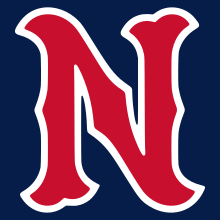
The Nashville Sounds are a Minor League Baseball team of the International League and the Triple-A affiliate of the Milwaukee Brewers. They are located in Nashville, Tennessee, and are named for the city's association with the music industry, specifically the "Nashville sound", a subgenre of country music which originated in the city in the mid-1950s. The team plays their home games at First Horizon Park, which opened in 2015 on the site of the historic Sulphur Dell ballpark. The Sounds previously played at Herschel Greer Stadium from its opening in 1978 until the end of the 2014 season. They are the oldest active professional sports franchise in Nashville.
Established as an expansion team of the Double-A Southern League in 1978, the Sounds led all of Minor League Baseball in attendance in their inaugural season and continued to draw the Southern League's largest crowds in each of their seven years as members. On the field, the team won six consecutive second-half division titles from 1979 to 1984 and won the Southern League championship twice: in 1979 as the Double-A affiliate of the Cincinnati Reds and again in 1982 as the Double-A affiliate of the New York Yankees. (Full article...) -
Image 7
Osborne Earl Smith (born December 26, 1954) is an American former professional baseball player. Nicknamed "The Wizard of Oz", Smith played shortstop for the San Diego Padres and St. Louis Cardinals in Major League Baseball, winning the National League Gold Glove Award for defensive play at shortstop for 13 consecutive seasons. A 15-time All-Star, Smith accumulated 2,460 hits and 580 stolen bases during his career, and won the National League Silver Slugger Award as the best hitter at shortstop in 1987. He was elected to the Baseball Hall of Fame in his first year of eligibility in 2002. He was also elected to the St. Louis Cardinals Hall of Fame in the inaugural class of 2014.
Smith was born in Mobile, Alabama; his family moved to Watts, Los Angeles, when he was six years old. While participating in childhood athletic activities, Smith possessed quick reflexes; he went on to play baseball at Locke High School in Los Angeles, then at California Polytechnic State University, San Luis Obispo. Drafted as an amateur player by the Padres, Smith made his major league debut in 1978. He quickly established himself as an outstanding fielder, and later became known for performing backflips on special occasions while taking his position at the beginning of a game. Smith won his first Gold Glove Award in 1980 and made his first All-Star Game appearance in 1981. (Full article...) -
Image 8
George Herman "Babe" Ruth (February 6, 1895 – August 16, 1948) was an American professional baseball player whose career in Major League Baseball (MLB) spanned 22 seasons, from 1914 through 1935. Nicknamed "the Bambino" and "the Sultan of Swat", he began his MLB career as a star left-handed pitcher for the Boston Red Sox, but achieved his greatest fame as a slugging outfielder for the New York Yankees. Ruth is regarded as one of the greatest sports heroes in American culture and is considered by many to be the greatest baseball player of all time. In 1936, Ruth was elected to the Baseball Hall of Fame as one of its "first five" inaugural members.
At age seven, Ruth was sent to St. Mary's Industrial School for Boys, a reformatory where he was mentored by Brother Matthias Boutlier of the Xaverian Brothers, the school's disciplinarian and a capable baseball player. In 1914, Ruth was signed to play Minor League baseball for the Baltimore Orioles but was soon sold to the Red Sox. By 1916, he had built a reputation as an outstanding pitcher who sometimes hit long home runs, a feat unusual for any player in the dead-ball era. Although Ruth twice won 23 games in a season as a pitcher and was a member of three World Series championship teams with the Red Sox, he wanted to play every day and was allowed to convert to an outfielder. With regular playing time, he broke the MLB single-season home run record in 1919 with 29. (Full article...) -
Image 9
William Harold Ponsford MBE (19 October 1900 – 6 April 1991) was an Australian cricketer. Usually playing as an opening batsman, he formed a successful and long-lived partnership opening the batting for Victoria and Australia with Bill Woodfull, his friend and state and national captain. Ponsford is the only player to twice break the world record for the highest individual score in first-class cricket; Ponsford and Brian Lara are the only cricketers to twice score 400 runs in an innings. Ponsford holds the Australian record for a partnership in Test cricket, set in 1934 in combination with Don Bradman (451 for 2nd wicket)—the man who broke many of Ponsford's other individual records. In fact, he along with Bradman set the record for the highest partnership ever for any wicket in Test cricket history when playing on away soil (451 runs for the second wicket)
Despite being heavily built, Ponsford was quick on his feet and renowned as one of the finest ever players of spin bowling. His bat, much heavier than the norm and nicknamed "Big Bertha", allowed him to drive powerfully and he possessed a strong cut shot. However, critics questioned his ability against fast bowling, and the hostile short-pitched English bowling in the Bodyline series of 1932–33 was a contributing factor in his early retirement from cricket a year and a half later. Ponsford also represented his state and country in baseball, and credited the sport with improving his cricketing skills. (Full article...) -
Image 10
Charles Dillon "Casey" Stengel (/ˈstɛŋɡəl/; July 30, 1890 – September 29, 1975) was an American Major League Baseball right fielder and manager, best known as the manager of the championship New York Yankees of the 1950s and later, the expansion New York Mets. Nicknamed "the Ol' Perfessor", he was elected to the Baseball Hall of Fame in 1966.
Stengel was born in Kansas City, Missouri, in 1890. In 1910, he began a professional baseball career that would span over half a century. After almost three seasons in the minor leagues, Stengel reached the major leagues late in 1912, as an outfielder, for the Brooklyn Dodgers. His six seasons there saw some success, among them playing for Brooklyn's 1916 National League championship team, but he also developed a reputation as a clown. After repeated clashes over pay with the Dodgers owner, Charlie Ebbets, Stengel was traded to the Pittsburgh Pirates in 1918; however, he enlisted in the Navy that summer, for the remainder of World War I. After returning to baseball, he continued his pay disputes, resulting in trades to the Philadelphia Phillies (in 1919) and to the New York Giants (in 1921). There, he learned much about baseball from the manager, John McGraw, and had some of the glorious moments in his career, such as hitting an inside-the-park home run in Game 1 of the 1923 World Series to defeat the Yankees. His major league playing career ended with the Boston Braves in 1925, but he then began a career as a manager. (Full article...) -
Image 11

WSNS-TV (channel 44) is a television station in Chicago, Illinois, United States, serving as the local outlet for the Spanish-language network Telemundo. It is owned and operated by NBCUniversal's Telemundo Station Group alongside NBC outlet WMAQ-TV (channel 5). The two stations share studios at the NBC Tower on North Columbus Drive in the city's Streeterville neighborhood and broadcast from the same transmitter atop the Willis Tower in the Chicago Loop.
WSNS-TV began broadcasting in 1970. Originally specializing in the automated display of news headlines, it evolved into Chicago's third full-fledged independent station, carrying movies, local sports, and other specialty programming. This continued until 1980, when WSNS became the Chicago-area station for ON TV, an over-the-air subscription television (STV) service owned by Oak Industries, which took a minority ownership stake in the station. While ON TV was successful in Chicago and the subscription system became the second-largest in the country by total subscribers, the rise of cable television precipitated the end of the business in 1985, with WSNS-TV as the last ON TV station standing. (Full article...) -
Image 12
Mariano Rivera (born November 29, 1969) is a Panamanian-American former professional baseball pitcher who played 19 seasons in Major League Baseball (MLB) for the New York Yankees, from 1995 to 2013. Nicknamed "Mo" and "Sandman", he spent most of his career as a relief pitcher and served as the Yankees' closer for 17 seasons. A thirteen-time All-Star and five-time World Series champion, he is MLB's career leader in saves (652) and games finished (952). Rivera won five American League (AL) Rolaids Relief Man Awards and three Delivery Man of the Year Awards, and he finished in the top three in voting for the AL Cy Young Award four times. He was inducted into the Baseball Hall of Fame as part of its class of 2019 in his first year of eligibility, and is to date the only player ever to be elected unanimously by the Baseball Writers' Association of America (BBWAA).
Raised in the modest Panamanian fishing village of Puerto Caimito, Rivera was an amateur player until he was signed by the Yankees organization in 1990. He debuted in the major leagues in 1995 as a starting pitcher, before permanently converting to a relief pitcher late that year. After a breakthrough season in 1996 as a setup man, he became the Yankees' closer in 1997. In the following seasons, he established himself as one of baseball's top relievers, leading the major leagues in saves in 1999, 2001, and 2004. Rivera primarily threw a sharp-moving, mid-90s mile-per-hour cut fastball that frequently broke hitters' bats and earned a reputation as one of the league's toughest pitches to hit. With his presence at the end of games, signaled by his foreboding entrance song "Enter Sandman", Rivera was a key contributor to the Yankees' dynasty in the late 1990s and early 2000s that won four championships in five years. He was an accomplished postseason performer, winning the 1999 World Series Most Valuable Player (MVP) Award and the 2003 AL Championship Series MVP Award, while setting postseason records that included lowest earned run average (ERA) (0.70) and most saves (42). (Full article...) -
Image 13Ross with the Montreal Wanderers, circa 1907–18
Arthur Howey Ross (January 13, 1885 – August 5, 1964) was a Canadian professional ice hockey player and executive from 1905 until 1954. Regarded as one of the best defenders of his era by his peers, he was one of the first to skate with the puck up the ice rather than pass it to a forward. He was on Stanley Cup championship teams twice in a playing career that lasted thirteen seasons; in January 1907 with the Kenora Thistles and 1908 with the Montreal Wanderers. Like other players of the time, Ross played for several different teams and leagues, and is noted for his time with the Wanderers while they were members of the National Hockey Association (NHA) and its successor, the National Hockey League (NHL). In 1911, he led one of the first organized player strikes over increased pay. When the Wanderers' home arena burned down in January 1918, the team ceased operations and Ross retired as a player.
After several years as an on-ice official, he was named head coach of the Hamilton Tigers for one season. When the Boston Bruins were formed in 1924, Ross was hired as the first coach and general manager of the team. He later coached the team on three separate occasions until 1945, and stayed as general manager until his retirement in 1954. Ross helped the Bruins finish first place in the league ten times and win the Stanley Cup three times; Ross personally coached the team to two of those victories. After being hired by the Bruins, Ross, along with his wife and two sons, moved to a suburb of Boston, and he became an American citizen in 1938. He died near Boston in 1964. (Full article...) -
Image 14
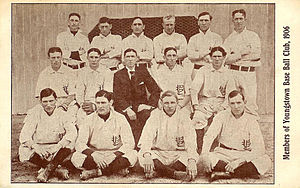
Youngstown Ohio Works (1906), with pitcher Roy Castleton seated in second row, second from left
The Youngstown Ohio Works baseball team was a minor league club that was known for winning the premier championship of the Ohio–Pennsylvania League in 1905, and for launching the professional career of pitcher Roy Castleton a year later. A training ground for several players and officials who later established careers in Major League Baseball, the team proved a formidable regional competitor and also won the 1906 league championship.
During its brief span of activity, the Ohio Works team faced challenges that reflected common difficulties within the Ohio–Pennsylvania League, including weak financial support for teams. Following a dispute over funding, the team's owners sold the club to outside investors, just a few months before the opening of the 1907 season. (Full article...) -
Image 15
Jack Roosevelt Robinson (January 31, 1919 – October 24, 1972) was an American professional baseball player who became the first African-American to play in Major League Baseball (MLB) in the modern era. Robinson broke the color line when he started at first base for the Brooklyn Dodgers on April 15, 1947. The Dodgers signing Robinson heralded the end of racial segregation in professional baseball, which had relegated black players to the Negro leagues since the 1880s.
Born in Cairo, Georgia, Robinson was raised in Pasadena, California. A four-sport student athlete at Pasadena Junior College and the University of California, Los Angeles, he was better known for football than he was for baseball, becoming a star college player with the UCLA Bruins football team. Following his college career, Robinson was drafted for service during World War II but was court-martialed for refusing to sit at the back of a segregated Army bus, eventually being honorably discharged. Afterwards, he signed with the Kansas City Monarchs of the Negro leagues, where he caught the eye of Branch Rickey, general manager of the Brooklyn Dodgers, who thought he would be the perfect candidate for breaking the color line in MLB. (Full article...)
General images - load new batch
-
Image 2Alexander Cartwright, father of modern baseball (from History of baseball)
-
Image 3A game from the Cantigas de Santa Maria, c. 1280, involving tossing a ball, hitting it with a stick and competing with others to catch it (from History of baseball)
-
Image 4Jackie Robinson in 1945, with the era's Kansas City Royals, a barnstorming squad associated with the Negro American League's Kansas City Monarchs (from History of baseball)
-
Image 6A New York Yankees batter (Andruw Jones) and a Boston Red Sox catcher at Fenway Park (from Baseball)
-
Image 9Baseball games sometimes end in a walk-off home run, with the batting team usually gathering at home plate to celebrate the scoring of the winning run(s). (from Baseball rules)
-
Image 10A runner sliding into home plate and scoring. (from Baseball)
-
Image 11The strike zone determines the result of most pitches, and varies in vertical length for each batter. (from Baseball)
-
Image 12Defensive positions on a baseball field, with abbreviations and scorekeeper's position numbers (not uniform numbers) (from Baseball)
-
Image 14Cy Young—the holder of many major league career marks, including wins and innings pitched, as well as losses—in 1908. MLB's annual awards for the best pitcher in each league are named for Young. (from Baseball)
-
Image 15Pitchers are generally substituted during mound visits (team gatherings at the pitcher's mound). (from Baseball rules)
-
Image 16A batter follows through after swinging at a pitched ball. (from Baseball rules)
-
Image 17A well-worn baseball (from Baseball)
-
Image 182013 World Baseball Classic championship match between the Dominican Republic and Puerto Rico, March 20, 2013 (from Baseball)
-
Image 19The standard fielding positions (from Baseball rules)
-
Image 20Japanese-Americans spectating a World War II-era game while in an internment camp. America's ties to immigrants and to Japan have been deeply shaped by a shared baseball heritage. (from History of baseball)
-
Image 22Pesäpallo, a Finnish variation of baseball, was invented by Lauri "Tahko" Pihkala in the 1920s, and after that, it has changed with the times and grown in popularity. Picture of Pesäpallo match in 1958 in Jyväskylä, Finland. (from Baseball)
-
Image 231906 World Series, infielders playing "in" for the expected bunt and the possible play at the plate with the bases loaded (from Baseball rules)
-
Image 24Sadaharu Oh managing the Japan national team in the 2006 World Baseball Classic. Playing for the Central League's Yomiuri Giants (1959–80), Oh set the professional world record for home runs with 868. (from History of baseball)
-
Image 25The typical motion of a right-handed pitcher (from Baseball rules)
-
Image 26By the 1860s Civil War, baseball (bottom) had overtaken its fellow bat-and-ball sport cricket (top) in popularity within the United States. (from History of baseball)
-
Image 27The NL champion New York Giants baseball team, 1913. Fred Merkle, sixth in line, had committed a baserunning gaffe in a crucial 1908 game that became famous as Merkle's Boner. (from History of baseball)
-
Image 28Two players on the baseball team of Tokyo, Japan's Waseda University in 1921 (from Baseball)
-
Image 29Pick-off attempt on runner (in red) at first base (from Baseball rules)
-
Image 30Fenway Park, home of the Boston Red Sox. The Green Monster is visible beyond the playing field on the left. (from Baseball)
-
Image 31An Afghan girl playing baseball in August 2002 (from Baseball)
-
Image 32Jackie Robinson in 1945, with the era's Kansas City Royals, a barnstorming squad associated with the Negro American League's Kansas City Monarchs (from Baseball)
-
Image 33Baserunners generally stand a short distance away from their base between pitches, preparing themselves to either go back or steal the next base. (from Baseball rules)
-
Image 34Rickey Henderson—the major leagues' all-time leader in runs and stolen bases—stealing third base in a 1988 game (from Baseball)
-
Image 35A first baseman receives a pickoff throw, as the runner dives back to first base. (from Baseball)
-
Image 36Sadaharu Oh managing the Japan national team in the 2006 World Baseball Classic. Playing for the Central League's Yomiuri Giants (1959–80), Oh set the professional world record for home runs. (from Baseball)
-
Image 37Cover of Official Base Ball Rules, 1921 edition, used by the American League and National League (from Baseball rules)
-
Image 38In May 2010, the Philadelphia Phillies' Roy Halladay pitched the 20th major league perfect game. That October, he pitched only the second no-hitter in MLB postseason history. (from History of baseball)
-
Image 40The American Tobacco Company's line of baseball cards featured shortstop Honus Wagner of the Pittsburgh Pirates from 1909 to 1911. In 2007, the card shown here sold for $2.8 million. (from Baseball)
-
Image 41Diagram of a baseball field Diamond may refer to the square area defined by the four bases or to the entire playing field. The dimensions given are for professional and professional-style games. Children often play on smaller fields. (from Baseball)
-
Image 43The strike zone, which determines the outcome of most pitches, varies in vertical length depending on the batter's typical height while swinging. (from Baseball rules)
-
Image 44A pitcher handing off the ball after being taken out of the game during a mound meeting. (from Baseball)
 Good articles - load new batch
Good articles - load new batch
-
Image 1
Fieldin Henry Culbreth III (born March 16, 1963) is an American former umpire in Major League Baseball (MLB). He worked in the American League from 1993 to 1999 and in both major leagues from 2000 until his retirement in 2021. Culbreth was promoted to crew chief prior to the 2013 season. Culbreth wore number 42 while he was an American League umpire, then changed to 25 in 2000 after the MLB umpires were unified into one crew.
Culbreth has umpired in five Division Series, six League Championship Series, three World Series and one All-Star Game, as well as the National League's single-game playoff in 2007. He has been part of the umpiring crew for two no-hitters, the first in 2010 by Matt Garza of the Tampa Bay Rays and the second by Johan Santana of the New York Mets. (Full article...) -
Image 2
Richard Benjamin Ferrell (October 12, 1905 – July 27, 1995) was an American professional baseball player, coach, scout, and executive. He played for 18 seasons as a catcher in Major League Baseball (MLB) from 1929 through 1947 for the St. Louis Browns, Boston Red Sox, and Washington Senators. His brother, Wes Ferrell, was a major league pitcher for 15 seasons, and they were teammates from 1933 through part of 1938 on the Red Sox and Senators. Following his three seasons in minor league baseball, he appealed to the Commissioner of Baseball to become a free agent, claiming that he was being held in the minors though he deserved promotion. The Commissioner agreed, and he was granted free agency; he signed with the St. Louis Browns.
Ferrell was regarded as one of the best catchers in baseball during the 1930s and early 1940s. While playing for the Red Sox in 1933, he and his brother Wes were selected to play for the American League (AL) team in the inaugural 1933 Major League Baseball All-Star Game held on July 6, 1933. His 1,806 games played as a catcher set an AL longevity record which stood for more than 40 years. A seven-time All-Star, Ferrell was elected to the Baseball Hall of Fame in 1984 by the Veterans Committee. After his playing career, he became a coach with the Senators, and later a scout and general manager with the Detroit Tigers. He died in July 1995 at the age of 89. (Full article...) -
Image 3
Gerald Dempsey "Buster" Posey III (born March 27, 1987) is an American former professional baseball catcher and is currently the president of baseball operations for the San Francisco Giants of Major League Baseball (MLB). He spent his entire 12-year Major League Baseball (MLB) career with the Giants, from 2009 until his retirement at the conclusion of the 2021 season.
Posey was born in Leesburg, Georgia. He played four sports in high school; in baseball, he excelled at hitting and pitching. He attended Florida State University, where he began playing the catcher and first base positions. He won the Golden Spikes Award and the Brooks Wallace Award in 2008. The Giants selected him with the fifth overall pick in the first round of the 2008 MLB draft. Posey made his MLB debut on September 11, 2009. He and Madison Bumgarner both made their Major League debuts in 2009 and established a reputation as one of the best batteries in recent MLB history. (Full article...) -
Image 4The Nashville Xpress were a Minor League Baseball team of the Southern League and the Double-A affiliate of the Minnesota Twins from 1993 to 1994. They were located in Nashville, Tennessee, and played their home games at Herschel Greer Stadium, sharing the ballpark with the Triple-A Nashville Sounds of the American Association. The Xpress were named for the trains which ran along tracks beyond the outfield wall and the team's sudden arrival and expected departure.
Formerly known as the Charlotte Knights, the Xpress were formed after the 1992 season when Charlotte, North Carolina, acquired a Triple-A expansion team in the International League, leaving the Southern League franchise in need of a new home. Larry Schmittou, president of the Triple-A Nashville club, offered to let the displaced team play at Greer Stadium until a permanent home could be found. Schmittou and the Sounds' staff served as caretakers of the team during the 1993 and 1994 seasons. Afterwards, the Xpress left Nashville to play on an interim basis in Wilmington, North Carolina, where they were known as the Port City Roosters in 1995 and 1996. The franchise eventually landed in Mobile, Alabama, as the Mobile BayBears in 1997. The team currently plays in Madison, Alabama, as the Rocket City Trash Pandas. (Full article...) -
Image 5
Alvin Ralph Dark (January 7, 1922 – November 13, 2014), nicknamed "Blackie" and "the Swamp Fox", was an American professional baseball shortstop and manager. He played fourteen years in Major League Baseball (MLB) for the Boston/Milwaukee Braves (1946, 1948–49, 1960), the New York Giants (1950–56), the St. Louis Cardinals (1956–58), the Chicago Cubs (1958–59), and the Philadelphia Phillies (1960). Later, he managed the San Francisco Giants (1961–64), the Kansas City/Oakland Athletics (1966–67, 1974–75), the Cleveland Indians (1968–71), and the San Diego Padres (1977). He was a three-time All-Star and a two-time World Series champion, once as a player (1954) and once as a manager (1974).
Born in Oklahoma, Dark grew up in Lake Charles, Louisiana. He played baseball, basketball, and football at Louisiana State University before transferring to Southwestern Louisiana Institute to engage in officer training for the United States Marine Corps. After serving in the Marines in 1945 and 1946, he signed with the Braves, debuting with them later that year. He spent 1947 in the minor leagues, then was named the major leagues' 1948 Rookie of the Year after batting .322 for the Boston Braves. Following the 1949 season, he was traded to the Giants, who were looking to improve their speed and fielding. Named the captain by Giants manager Leo Durocher, he hit .300 or more three times while playing for the Giants, and became the first National League (NL) shortstop to hit 20 home runs more than once. He batted over .400 in the 1951 World Series and the 1954 World Series, the latter of which New York won by sweeping the Cleveland Indians. Traded to the Cardinals in 1956, Dark served as their starting shortstop through the beginning of the 1958 season, when his diminished range caused him to be shifted to third base. He spent most of 1958 and all of 1959 with the Cubs, then played for the Phillies and Braves in 1960 before retiring as a player. Dark had 2,089 hits in his career. Of the three shortstops in New York following World War II, Dark had a higher batting average and more home runs than Phil Rizzuto or Pee Wee Reese, despite the fact that he is the only one not in the National Baseball Hall of Fame and Museum. (Full article...) -
Image 6The Calgary Cannons were a minor league baseball team located in Calgary, Alberta, for 18 seasons, from 1985 until 2002. They were a member of the AAA Pacific Coast League (PCL) and played at Foothills Stadium. The Cannons displaced the Calgary Expos, who played in the rookie level Pioneer League from 1977 until 1984. The team was previously known as the Salt Lake City Gulls before being relocated to Calgary. Following the 2002 season, the team moved to Albuquerque, New Mexico, where they became the Isotopes.
The Cannons played 2,538 regular season games in Calgary, compiling a record of 1,225–1,308. They qualified for the playoffs five times: 1985, 1987, 1989, and 1991 as an affiliate of the Seattle Mariners, and 1998 as an affiliate of the Chicago White Sox. They reached the PCL Championship Series three times, in 1987, 1991, and 1998, though they never won a title. (Full article...) -
Image 7
Edwar Emilio Ramírez (born 28 March 1981) is a Dominican former professional baseball pitcher. Ramírez appeared in Major League Baseball (MLB) as a relief pitcher for the New York Yankees (2007–2009) and Oakland Athletics (2010). After finding himself out of baseball in 2004, Ramírez revitalized his career by developing an effective changeup.
Originally a member of the Los Angeles Angels of Anaheim organization, Ramírez pitched for the Angels only in minor league baseball. The Angels released Ramírez before the 2004 season. After spending the next year mastering a changeup, he spent parts of the following two seasons in independent league baseball. Ramírez signed with the Yankees in 2006, and made his MLB debut the next season. Ramírez enjoyed success and popularity among the fan base during the 2007 and 2008 seasons. He struggled in 2009, and pitched for the Athletics early in the 2010 season before returning to minor league baseball in the Athletics organization. He pitched in the Mexican League in 2011. (Full article...) -
Image 8
Glenn Scobey Warner (April 5, 1871 – September 7, 1954), most commonly known as Pop Warner, was an American college football coach at various institutions who is responsible for several key aspects of the modern game. Included among his innovations are the single and double wing formations (precursors of the modern spread and shotgun formations), the three point stance and the body blocking technique. Fellow pioneer coach Amos Alonzo Stagg called Warner "one of the excellent creators". He was inducted as a coach into the College Football Hall of Fame as part of its inaugural class in 1951. He also contributed to a junior football program which became known as Pop Warner Little Scholars, a popular youth American football organization.
In the early 1900s, he created a premier football program at the Carlisle Indian Industrial School—a federally-funded, off-reservation American Indian boarding school. He also coached teams to four national championships: Pittsburgh in 1915, 1916, and 1918 and Stanford in 1926. In all, he was head coach at the University of Georgia (1895–1896), Iowa Agricultural College and Model Farm (1895–1899), Cornell University (1897–1898 and 1904–1906), Carlisle (1899–1903 and 1907–1914), Pittsburgh (1915–1923), Stanford (1924–1932) and Temple University (1933–1938), compiling a career college football record of 319–106–32. Predating Bear Bryant, Eddie Robinson, and Joe Paterno, he once had the most wins of any coach in college football history. (Full article...) -
Image 9
Daniel Thomas Meyer (born August 3, 1952) is an American former professional baseball player whose career spanned 17 seasons, 12 of which were played in Major League Baseball (MLB) with the Detroit Tigers (1974–76), the Seattle Mariners (1977–81), and the Oakland Athletics (1982–85). Meyer primarily played first base, but also played left field, third base, and right field. He batted left-handed while throwing right-handed. During his playing career, Meyer was listed at 5 feet 11 inches (180 cm) and weighed 180 pounds (82 kg).
After attending the University of Arizona and Santa Ana College, Meyer was drafted by the Detroit Tigers during the 1972 Major League Baseball draft. He began his career in the minor leagues with the Bristol Tigers. Meyer made his major league debut in 1974. Over his career in the majors, Meyer compiled a .253 batting average with 411 runs scored, 944 hits, 153 doubles, 31 triples, 86 home runs, and 459 runs batted in (RBIs) in 1,118 games played. (Full article...) -
Image 10
Alec Daniel Bohm (born August 3, 1996) is an American professional baseball third baseman for the Philadelphia Phillies of Major League Baseball (MLB).
Born and raised in Omaha, Nebraska, Bohm was a standout hitter for Roncalli Catholic High School but was not selected in the 2015 MLB Draft. Instead, out of high school, he chose to play college baseball for the Wichita State Shockers. Bohm was offensively productive in his three years with the Shockers, maintaining a batting average of over .300 in his tenure. Outside of Wichita State, Bohm also played collegiate summer baseball in both the Coastal Plain League and the Cape Cod Baseball League. (Full article...) -
Image 11
The 2009 American League Central tie-breaker game was a one-game extension to Major League Baseball's (MLB) 2009 regular season, played between the Detroit Tigers and Minnesota Twins to determine the champion of the American League's (AL) Central Division. It was played at the Hubert H. Humphrey Metrodome in Minneapolis, Minnesota, on October 6, 2009. The Twins won the game 6–5 in a thrilling 12-inning battle, and advanced to the 2009 AL Division Series where they were swept by the New York Yankees; the Tigers failed to qualify for the postseason.
A tie-breaker was necessary after both teams finished the season with identical win–loss records of 86–76. Due to a rules changes prior to the 2009 season, the Twins were awarded home-field advantage by winning the regular season series 11–7 against the Tigers. It was the third tie-breaker played in MLB from 2007 to 2009. It was also the second consecutive tiebreaker for the AL Central title after 2008, when the Chicago White Sox defeated the Twins to win the division. The Twins became the only MLB team to contest tie-breaker games of any sort (divisional and/or wild card) in consecutive seasons. The tie-breaker counted as the 163rd regular season game played by both teams and all events in the game were added to regular season statistics. This was the Twins' final regular season game at the Metrodome as the team moved to Target Field for the 2010 season. The tie-breaker was later named the Best Regular-Season Game of the Decade by Sports Illustrated. (Full article...) -
Image 12

Morris Arnovich (November 16, 1910 – July 20, 1959), nicknamed "Snooker", was an American baseball player. Arnovich played in Major League Baseball between 1936 and 1946 and played in the World Series winning team in 1940 as a part of the Cincinnati Reds. Playing as a line drive hitter, and fielding as an outfielder he began in MLB for the Philadelphia Phillies in 1936 where he played four seasons before joining the Reds for a season. After his time in Cincinnati, he joined the New York Giants for the 1941 season, and again for one game in 1946 after joining the United States Army.
A member of the 1939 National League All-Star team, he finished his career with a .287 batting average. After retiring, Arnovich coached basketball and died in 1959 of a coronary occlusion. (Full article...) -
Image 13
E. Roy Lester (October 3, 1923 – May 3, 2020) was an American college and high school football coach. After a successful career at the high school level, he served as the head coach of the University of Maryland football team from 1969 to 1971. Lester was the school's fourth head coach in five years, and compiled a 7–25 record during his tenure. He was fired after the 1971 season when Maryland finished at the bottom of the Atlantic Coast Conference for the second consecutive year.
Lester returned to coach interscholastic football, including as head coach of Richard Montgomery High School where his teams compiled an 86–10–1 record and six undefeated seasons. His high school teams won three Maryland state championships. Lester attended West Virginia University where he was a three-sport athlete and earned letters in football, baseball, and basketball. He was inducted into the West Virginia University Sports Hall of Fame in 2008. (Full article...) -
Image 14

Curtis Benjamin Roberts (August 16, 1929 – November 14, 1969) was an American baseball second baseman who played three seasons for the Pittsburgh Pirates in Major League Baseball from 1954 to 1956. He was signed by the Boston Braves as an amateur free agent before the 1951 season, and obtained by Pittsburgh a year later. After two seasons in the Pirates farm system, Major League Baseball recognizes Roberts as the first black player for the Pirates. After becoming the starting second baseman for the Pirates in his rookie year, Roberts' playing time decreased and he was out of the Majors within three seasons. He then played for multiple teams in the minor leagues before retiring from professional baseball in 1963.
A native of Pineland, Texas, but raised in Oakland, California, Roberts was considered short by Major League standards, standing 5 ft 8 in (1.73 m). Roberts was a skilled defensive player, but he could not hit with enough proficiency to remain in the major leagues. Roberts died when an automobile struck him while he was changing a tire on his car. His former Pirates teammates only learned of his death 20 years later when being interviewed for a newspaper article. Although Roberts' career was short, it paved the way for other black players to debut for the Pirates, the most notable of whom was future Baseball Hall of Famer Roberto Clemente. (Full article...) -
Image 15
Ernest Banks (January 31, 1931 – January 23, 2015), nicknamed "Mr. Cub" and "Mr. Sunshine", was an American professional baseball player who starred in Major League Baseball (MLB) as a shortstop and first baseman for the Chicago Cubs between 1953 and 1971. He was inducted into the National Baseball Hall of Fame in 1977, and was named to the Major League Baseball All-Century Team in 1999.
Banks is regarded as being one of the greatest players of all time. He began playing professional baseball in 1950 with the Kansas City Monarchs in the Negro leagues. He served in the U.S. military for two years, played for the Monarchs again, and began his National League career in September 1953. The following year, Banks was the National League Rookie of the Year runner-up. Beginning in 1955, Banks was a National League (NL) All-Star for 11 seasons, playing in 13 of the 15 All-Star Games held during those years. Banks was the Cubs' main attraction in the late 1950s, the National League Most Valuable Player in 1958 and 1959, and the Cubs' first Gold Glove winner in 1960. (Full article...)
Did you know (auto-generated) - load new batch

- ... that Major League Baseball player Wade Meckler was 4 feet 10 inches (1.47 metres) tall and weighed 75 pounds (34 kilograms) when he was a high-school freshman?
- ... that labor lawyer Dick Moss argued the 1975 case which resulted in the establishment of free agency in Major League Baseball?
- ... that Dr. Twink Twining was a Major League Baseball player?
- ... that Gaylord Perry admitted that he had cheated in baseball in his autobiography Me and the Spitter?
- ... that before his Major League Baseball career, Leo Posada represented Cuba internationally in cycling?
- ... that Major League Baseball pitcher Charlie Gray was billed as his team's pitcher "of six fingers and six toed fame" and called "a freak" by the Sporting Life?
- ... that Frankie Saluto was a member of the Ringling Giants, a dwarf baseball team that raised money for charity?
- ... that before Major League Baseball pitcher Keaton Winn was called up to the majors in June 2023, he had never been to a major league stadium?
Quotes
| When you make a bad pitch and the hitter puts it out of the park and you cost your team the game, it's a real test of your maturity to be able to stand in front of your locker fifteen minutes later and admit it to the world. How many people in other professions would be willing to have their job performances evaluated that way, in front of millions, every afternoon at five o'clock. |
 Featured lists - load new batch
Featured lists - load new batch
-
Image 1The Toronto Blue Jays are members of the American League (AL) East Division in Major League Baseball (MLB). There have been 14 different managers of the Blue Jays, the only Canadian baseball franchise in Major League Baseball. In baseball, the head coach of a team is called the manager (or more formally, the field manager). They are the only team outside the United States to win a World Series, and the first team to win a World Series in Canada. John Schneider was the interim manager, until the club named him their full time manager in the off season and giving him a three-year contract after, replacing Charlie Montoyo; Montoyo was fired on July 13, 2022.
Cito Gaston has both managed and won the most games of any Blue Jays manager, with 1,731 games and 894 wins. He is followed by John Gibbons in both categories, with 1,258 games and 644 wins, who surpassed Bobby Cox's marks during his second stint as manager. Gaston is the only Blue Jays manager to win a World Series in 1992 and 1993, the fourth African-American manager in MLB history, and was the first African-American manager to win a World Series. Cox is the only Blue Jays manager to be awarded the AL Manager of the Year Award in 1985. Mel Queen has the best winning percentage by winning 80 percent of his 5 games coached. (Full article...) -
Image 2Statistics current through October 9, 2024 (Full article...)
-
Image 3In its 123-year history, the Baltimore Orioles baseball franchise of Major League Baseball's American League has employed 42 managers. The duties of the team manager include team strategy and leadership on and off the field. Of those 42 managers, 12 have been "player-managers"; specifically, they managed the team while still being signed as a player. Since 1992, the team has played its home games at Oriole Park at Camden Yards.
The Baltimore franchise began operations in Milwaukee, Wisconsin, as the Brewers (not to be confused with the current National League team of the same name) in 1901. After one season in Wisconsin under manager and Hall of Famer Hugh Duffy, the franchise moved south to St. Louis, Missouri, adopting the St. Louis Browns name and hiring a new manager, Jimmy McAleer. The Browns remained in Missouri until the end of the 1953 season, when Major League Baseball's owners elected to move the franchise to Baltimore, Maryland, where they were renamed the Orioles, after Maryland's state bird. (Full article...) -
Image 4

Carlos Zambrano was the Cubs' Opening Day starting pitcher from 2005 to 2010.
The Chicago Cubs are a Major League Baseball franchise based in Chicago that plays in the National League Central division. In the history of the franchise, it has also played under the names Chicago White Stockings, Chicago Colts and Chicago Orphans. The first game of the new baseball season for a team is played on Opening Day, and being named the Opening Day starter is an honor, which is often given to the player who is expected to lead the pitching staff that season, though there are various strategic reasons why a team's best pitcher might not start on Opening Day. The Cubs have used 68 different starting pitchers on Opening Day since they first became a Major League team in 1876. The Cubs have a record of 74 wins, 60 losses and 2 ties in their Opening Day games.
The Cubs have played in seven different home ball parks. They have played at their current home, Wrigley Field, since 1916. They have a record of 22 wins, 21 losses and 1 tie in Opening Day games at Wrigley Field. They had an Opening Day record of six wins, one loss and one tie at their other home ball parks, for a total home record in Opening Day games of 28 wins, 22 losses and 2 ties. Their record in Opening Day away games is 46 wins and 38 losses. (Full article...) -
Image 5
An All-American team is an honorary sports team composed of the best amateur players of a specific season for each position—who in turn are given the honorific "All-America" and typically referred to as "All-American athletes", or simply "All-Americans". Although the honorees generally do not compete as a unit, the term is used in U.S. team sports to refer to players who are selected by members of the national media. Walter Camp selected the first All-America team in the early days of American football in 1889. In 1950, the American Baseball Coaches Association (ABCA) selected its first All-American baseball team. It has since chosen All-American teams and a player of the year for each division (National Collegiate Athletic Association (NCAA) Division I, Division II, Division III, National Association of Intercollegiate Athletics, junior college and high school). Collegiate Baseball selects All-American, Freshman All-American and High School All-American teams. Baseball America magazine selects pre-season and post-season All-American teams and College Player of the Year honorees.
Various organizations selected All-American lists of the best players for the 1993 NCAA Division I college baseball season. The ABCA, the magazine Baseball America, and Collegiate Baseball were the NCAA-sanctioned selectors. This list only includes players selected to the post-season All-American first team for each selector. However, many All-American selections choose second, third, etc. teams from the remaining eligible candidates. (Full article...) -
Image 6

Location of Puerto Rico's main island (green)
Puerto Rico currently has the fourth-most active players in Major League Baseball (MLB) among Latin American jurisdictions, behind the Dominican Republic, Venezuela and Cuba. More than three hundred players from the archipelago have played in the major leagues since 1926. This includes players who were born in either one of the archipelago's islands and those of Puerto Rican heritage. Only those players who have worked in the major leagues are listed, not those active in the minor leagues, nor negro independent leagues.
For years, it was considered that the first player from Puerto Rico to play in the major leagues was Hiram Bithorn in 1942. But this changed in December 2020, when seven Negro baseball leagues between 1920 and 1948 were recognized as "major leagues." Thus, the first Puerto Rican to play baseball on the major leagues was Jose "Gacho" Torres, who debuted in 1926. (Full article...) -
Image 7

Eddie Guardado, a pitcher for the 1993 Xpress, was called up after 10 starts to make his MLB debut with the Minnesota Twins on June 13, 1993.
The Nashville Xpress Minor League Baseball team played two seasons in Nashville, Tennessee, from 1993 to 1994 as the Double-A affiliate of the Minnesota Twins. In those seasons, a total of 60 players competed in at least one game for the Xpress. The 1993 roster included a total of 35 players, while 38 played for the team in 1994. There were 13 players who were members of the team in both seasons. Of the 60 all-time Xpress players, 22 also played in at least one game for a Major League Baseball (MLB) team during their careers.
After the 1992 baseball season, Charlotte, North Carolina, home of the Double-A Southern League's Charlotte Knights, acquired a Triple-A expansion team in the International League, leaving the Southern League franchise in need of a new home. Larry Schmittou, president of the Triple-A Nashville Sounds, offered Herschel Greer Stadium as a temporary home for the displaced team until owner George Shinn could find a permanent home for his club. Upon the league's approval, the franchise relocated to Nashville and became the Nashville Xpress. In order to accommodate two teams at Greer, the Xpress' games were scheduled for during the Sounds' road trips. (Full article...) -
Image 8

Giancarlo Stanton holds 10 records for the Marlins franchise, the most of any Marlins player.
The Miami Marlins are a Major League Baseball (MLB) franchise based in the U.S. state of Florida. The Marlins became members of MLB as an expansion team in the 1993 season. Through 2017, they have played 3,981 games, winning 1,870 and losing 2,111 for a winning percentage of .470. This list documents the superlative records and accomplishments of team members during their tenures as Marlins in MLB's National League East.
Giancarlo Stanton holds the most franchise records as of the end of the 2018 season, with ten records, including both the most career and single-season home runs, RBI, slugging percentage, and total bases records. (Full article...) -
Image 9
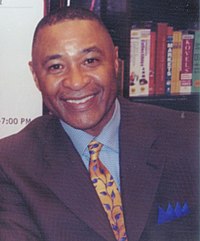
Ozzie Smith has won 13 Gold Glove Awards at shortstop, tying him for the third-highest total among winners at all positions.
The Rawlings Gold Glove Award, usually referred to as the Gold Glove, is the award given annually to the Major League Baseball players judged to have exhibited superior individual fielding performances at each fielding position in both the National League (NL) and the American League (AL), as voted by the managers and coaches in each league. Managers are not permitted to vote for their own players. Eighteen Gold Gloves are awarded each year (with the exception of 1957, 1985, 2007, and 2018), one at each of the nine positions in each league. In 1957, the baseball glove manufacturer Rawlings created the Gold Glove Award to commemorate the best fielding performance at each position. The award was created from a glove made from gold lamé-tanned leather and affixed to a walnut base. Initially, only one Gold Glove per position was awarded to the top fielder at each position in the entire league; however, separate awards were given for the National and American Leagues beginning in 1958.
Ozzie Smith, known as "the Wizard of Oz", has won the most Gold Glove Awards at shortstop; he captured 13 awards in his 19 seasons with the St. Louis Cardinals. Omar Vizquel is second among shortstops with 11 wins; he won two with the San Francisco Giants in the National League after winning nine with the Seattle Mariners and the Cleveland Indians in the American League. Luis Aparicio won nine times at shortstop for the third-highest total, followed by Mark Belanger with eight wins. Dave Concepción and Derek Jeter have won five awards; four-time winners at shortstop include Brandon Crawford, Tony Fernández, Jimmy Rollins, Andrelton Simmons and Alan Trammell. Hall of Famers who have won Gold Glove Awards at shortstop include Smith, Aparicio, Trammell, Ernie Banks, Robin Yount, Barry Larkin and Cal Ripken Jr., whose 2,632 consecutive games played earned him his "Iron Man" nickname. (Full article...) -
Image 10
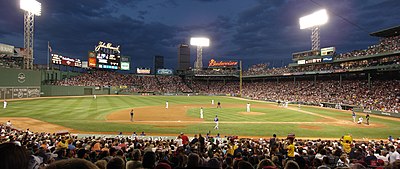
Fenway Park, Boston's home ballpark since 1912
The Boston Red Sox are a Major League Baseball (MLB) franchise based in Boston, Massachusetts. They have played in the American League since it was founded in 1901, and the American League East since divisions were introduced in 1969. The first game of each baseball season for a team is known as Opening Day, for which being named the starting pitcher is an honor. That honor is often given to the player who is expected to lead the pitching staff that season, although there are various strategic reasons why a team's best pitcher might not start on Opening Day. (Full article...) -
Image 11

Manager Fran Riordan looks on as Melvin Mercedes slides into third base.
The Nashville Sounds Minor League Baseball team has played in Nashville, Tennessee, since being established in 1978 as an expansion team of the Double-A Southern League. They moved up to Triple-A in 1985 as members of the American Association before joining the Pacific Coast League in 1998. With the restructuring of the minor leagues in 2021, they were placed in the Triple-A East, which became the International League in 2022. The team has been led by 29 managers throughout its history. Managers are responsible for team strategy and leadership on and off the field, including determining the batting order, arranging defensive positioning, and making tactical decisions regarding pitching changes, pinch-hitting, pinch-running, and defensive replacements. Rick Sweet has been the Sounds' manager since 2021.
As of the completion of the 2024 season, Nashville's managers have led the club for 6,566 regular-season games in which they have compiled a win–loss record of 3,398–3,168–2 (.518). In 16 postseason appearances, their teams have a record of 49–44 (.527) and have won two Southern League championships and one Pacific Coast League championship. Combining all 6,659 regular-season and postseason games, the Sounds have an all-time record of 3,447–3,212–2 (.523). (Full article...) -
Image 12The Cleveland Guardians (formerly known as the Indians) are a professional baseball franchise based in Cleveland, Ohio that formed in 1901. They are members of the Central division of Major League Baseball's American League. The current manager of the Guardians is Stephen Vogt, who replaced Terry Francona after he stepped down at the end of the 2023 season.
Cleveland has had 47 managers in their major league history. Jimmy McAleer became the first manager of the then Cleveland Blues in 1901, serving for one season. In 1901, McAleer was replaced with Bill Armour. Cleveland made their first playoff appearance under Tris Speaker in 1920. Out of the eight managers that have led Cleveland into the postseason, only Speaker and Lou Boudreau have led Cleveland to World Series championships, doing so in 1920 and 1948, respectively. Al López (1954), Mike Hargrove (1995 and 1997) and Terry Francona (2016) have also appeared in World Series with Cleveland. The highest winning percentage of any manager who managed at least one season was López, with a percentage of .617. The lowest percentage was Johnny Lipon's .305 in 1971, although he managed for only 59 games. The lowest percentage of a manager with at least one season with Cleveland was McAleer's .397 in 1901. (Full article...) -
Image 13

Roy Halladay (1995) is the only Blue Jays' first-round pick to be inducted into the Baseball Hall of Fame, and to win a Cy Young Award with the team.
The Toronto Blue Jays are a Major League Baseball (MLB) franchise based in Toronto, Ontario, Canada. They play in the American League East division. Since the Blue Jays' entrance into the league in 1977, the Blue Jays have selected 72 players in the first round. Officially known as the "First-Year Player Draft", the Rule 4 draft is MLB's primary mechanism for assigning amateur players from high schools, colleges, and other amateur clubs to its teams. The draft order is determined based on the previous season's standings, with the team possessing the worst record receiving the first pick. In addition, teams which lost free agents in the previous off-season may be awarded compensatory or supplementary picks. The First-Year Player Draft is unrelated to the 1976 expansion draft in which the Blue Jays initially filled their roster.
Of the 72 players picked in the first round by Toronto, 35 have been pitchers, the most of any position; 26 of them were right-handed, while nine were left-handed. 14 shortstops, 12 outfielders, four catchers and third basemen, and three first basemen have also been selected. The team has never drafted a player at second base in the first round. 38 players were drafted out of high school, while 31 came from four-year college programs and two from junior colleges. They have also drafted two players from Puerto Rico: Alex Ríos (1999) and Miguel Negrón (2000). (Full article...) -
Image 14

Craig Biggio (1987) is the only first-round draft pick of the Astros with over 3000 career hits.
The Houston Astros, originally called the "Colt .45s", are a Major League Baseball (MLB) franchise based in Houston, Texas. They play in the American League West division. Since the institution of Major League Baseball's Rule 4 Draft, the Astros have selected 57 players in the first round. Officially known as the "First-Year Player Draft", the Rule 4 Draft is Major League Baseball's primary mechanism for assigning amateur baseball players from high schools, colleges, and other amateur baseball clubs to its franchises. The draft order is determined based on the previous season's standings, and the team that had the worst record receives the first pick. In addition, teams which lost free agents in the previous off-season may be awarded compensatory or supplementary picks. The First-Year Player Draft is unrelated to the 1961 expansion draft in which the Astros initially filled their roster.
Of the 57 players picked in the first round by Houston, 24 have been pitchers, the most of any position; 21 of these were right-handed, while 3 were left-handed. Ten catchers were selected, while nine outfielders, nine shortstops, two first basemen, and two third basemen were taken as well. The team also selected one player at second base. Thirteen of the players came from high schools or universities in the state of California, while Texas and Tennessee follow with five and three players, respectively. They have also drafted two players from outside the United States: Carlos Correa (2012) and Ramón Castro (1994), both from Puerto Rico. (Full article...) -
Image 15The New York Mets are a professional Major League Baseball (MLB) franchise based in New York City, New York in the borough of Queens. They play in the National League East division. In the history of the Mets, there have been 23 managers that managed a game including four interim managers. Of those managers, only Joe Torre was a player-manager (a manager who also plays for the team); Yogi Berra did play four games while he was a coach for the Mets in 1965. Gil Hodges, Roy McMillan, Bud Harrelson, Mike Cubbage, Dallas Green, Bobby Valentine and Willie Randolph all also played in MLB for the Mets prior to becoming the team's manager.
The Mets posted their franchise record for losses in their inaugural season in the league, with 120 losses in 160 games in 1962. This was the first of seven consecutive losing seasons, a season in which the winning percentage was below .500, and the most losses by a post-1900 MLB team. During this stretch from 1962 to 1968, the Mets employed four managers. Seven managers have taken the Mets to the postseason; Davey Johnson, Bobby Valentine and Terry Collins have led the team to two playoff appearances each. Johnson and Gil Hodges are the only Mets managers to win a World Series: Hodges in 1969 against the Baltimore Orioles; and Johnson in 1986 against the Boston Red Sox. Terry Collins is the longest-tenured manager in franchise history, with 1,134 games of service over 7 seasons. (Full article...)
More did you know
- ...that on Mother's Day, May 14, 2006, the Louisville Slugger Company produced more than 400 pink baseball bats for game use by more than 50 professional baseball players?
- ... that the 12–6 curveball gets its name from the way the pitch breaks downward, looking like it moves from the number 12 to the number 6 on a clock?
- ... that Lou Marson hit his first major league home run on the final day of the Philadelphia Phillies’ World Series-winning 2008 season?
- ...that Jerry Dybzinski's baserunning error in game four of the 1983 American League Championship Series ultimately cost the Chicago White Sox both the game and the series?
- ... that Nick Castellanos received a $3.45 million signing bonus from the Detroit Tigers, the highest ever for a player not drafted in the first round in the Major League Baseball Draft?
Sports portals
Selected picture
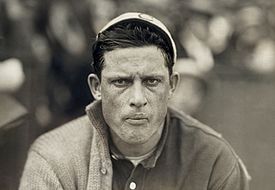
| Credit: Paul Thompson |
Edward Augustine Walsh (May 14, 1881 – May 26, 1959) was a Major League Baseball pitcher. He holds the record for lowest career ERA, 1.82. Born in Plains Township, Pennsylvania, Walsh had a brief though remarkable major league career. He made his major league debut in 1904 with the Chicago White Sox and pitched his first full season in 1906, going 17-13 with a 1.88 ERA and 171 strikeouts.
Associated Wikimedia
The following Wikimedia Foundation sister projects provide more on this subject:
-
Commons
Free media repository -
Wikibooks
Free textbooks and manuals -
Wikidata
Free knowledge base -
Wikinews
Free-content news -
Wikiquote
Collection of quotations -
Wikisource
Free-content library -
Wikiversity
Free learning tools -
Wiktionary
Dictionary and thesaurus
More portals
- Portals with triaged subpages from June 2018
- All portals with triaged subpages
- Portals with no named maintainer
- Automated article-slideshow portals with 51–100 articles in article list
- Automated article-slideshow portals with 501–1000 articles in article list
- Random portal component with 41–50 available subpages
- Automated article-slideshow portals with 201–500 articles in article list
- Random portal component with 11–15 available subpages
- Random portal component with 21–25 available image subpages


![Image 1 Advertisement in Billboard magazine in 1907 How Brown Saw the Baseball Game is an American short silent comedy film produced in 1907 and distributed by the Lubin Manufacturing Company. The film follows a baseball fan named Mr. Brown who overdrinks before a baseball game and becomes so intoxicated that the game appears to him in reverse motion. During production, trick photography was used to achieve this effect. The film was released in November 1907. It received a positive review in a 1908 issue of The Courier-Journal that reported the film was successful and "truly funny". As of 2021[update], it is unclear whether the print of the film has survived. The identities of the film cast and production crew are unknown. Film historians have noted similarities between the plot of How Brown Saw the Baseball Game and How the Office Boy Saw the Ball Game. It is a comedy film directed by Edwin S. Porter, having released a year before How Brown Saw the Baseball Game. (Full article...)](http://upload.wikimedia.org/wikipedia/en/d/d2/Blank.png)


